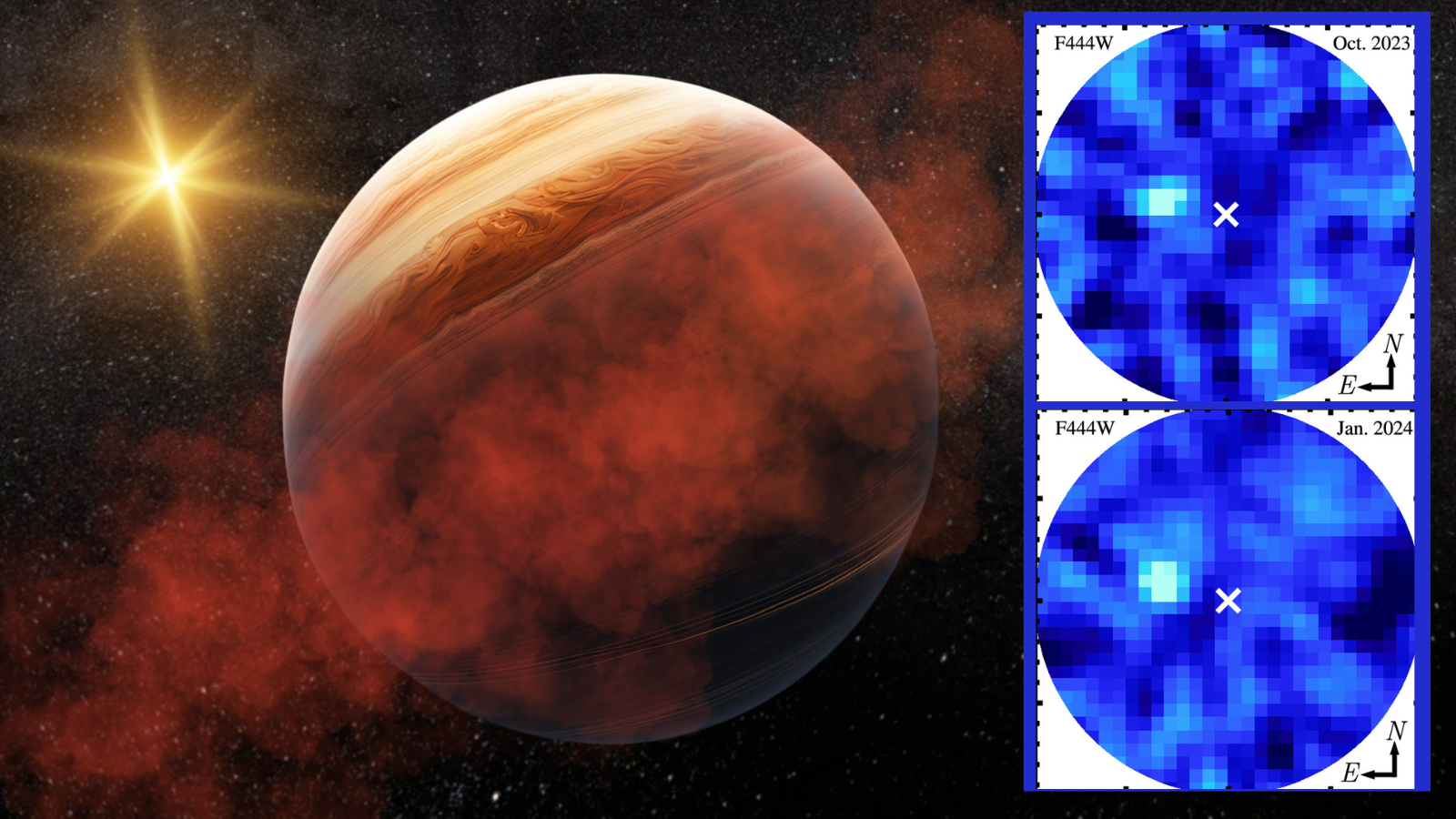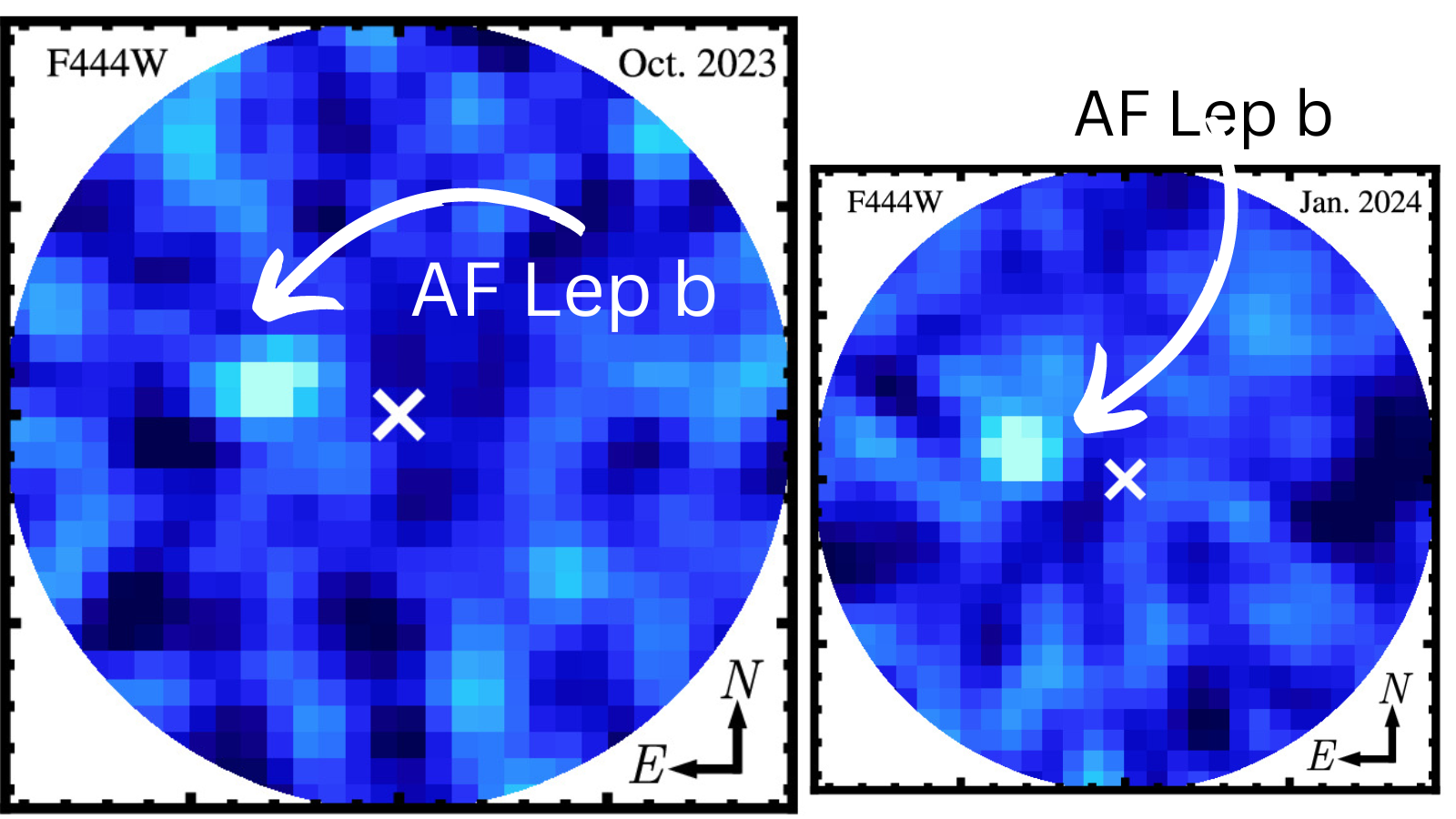James Webb Space Telescope wins 'race against time' to directly observe young exoplanet
Astronomers had to beat the clock to see the exoplanet before it disappeared for a decade.

The James Webb Space Telescope has directly imaged its lowest mass extrasolar planet outside the solar system yet. The planet is also the closest to its star to be directly observed by the $10 billion space telescope.
The imaging was a "race against time" with the extrasolar planet, or "exoplanet," about to disappear behind the blinding light of its parent star, perhaps for as long as a decade.
The planet AF Leporis b (AF Lep b) is no stranger to setting records. In 2023, this extrasolar planet, or "exoplanet," became the lowest-mass planet beyond the solar system to be discovered by direct observation. It then became the lowest-mass world to have its mass measured by "astrometry," a technique that monitors the motion of a star over many years to identify "wobbles" caused by the gravitational tug of an orbiting planet.
AF Lep b is a young exoplanet estimated to be just 23 million years old. If that sounds ancient, consider that the Earth is estimated to be 4.6 billion years old. AF Lep b has a mass around 3.2 times that of Jupiter and a width around 1.2 times that of the solar system gas giant.
"AF Lep b is right at the inner edge of being detectable. Even though it is extraordinarily sensitive, JWST is smaller than our largest telescopes on the ground," University of Texas at Austin researcher Kyle Franson said in a statement. "And we’re observing at longer wavelengths, which has the effect of making objects look fuzzier. It becomes difficult to separate one source from another when they appear so close together."
Related: James Webb Space Telescope finds 'puffball' exoplanet is uniquely lopsided
Yet, because it is 88 light-years from Earth, AF Lep b still appears to the James Webb Space Telescope (JWST) as little more than a speck. Fortunately, astronomers can learn a heck of a lot from such a "speck."
Get the Space.com Newsletter
Breaking space news, the latest updates on rocket launches, skywatching events and more!
A firefly on a lighthouse
Since the discovery of the first exoplanet in the 1990s, the exoplanet catalog has burgeoned to over 6,000 entries, with thousands more to be confirmed. Yet, very few of these have been directly imaged.
Most exoplanets are detected via their effect on their host star, either when they block light as they cross the face of their star or from gravitational tugs they exert on that star.
That is because when viewed from many light-years away, the angular separation between exoplanets and their host stars becomes very small, making them hard to distinguish and overwhelmed by their stars' light. This can be thought of as standing on the deck of a ship offshore and attempting to see the light of a firefly sitting on the illuminated lamp of a lighthouse.
The JWST has an advantage in observing exoplanets around their stars, an instrument called a coronagraph. This blocks out light from a star so planets orbiting them are more easily observed. AF Lep b is a good candidate for such an observation because, as a very young planet, its "firefly glow" is strong.
The team wanted to learn more about the atmosphere of this exoplanet because worlds like AF Lep b with masses similar to those of solar system gas giants are rare. But to do this, the team had to move quickly.

This race against time for these astronomers emerged because the distant gas giant is currently around eight times the distance between Earth and the sun from its star, but its orbit is moving closer to the star from our perspective.
At its current distance from its star, the coronagraph blocks 90% of AF Lep's light, but as the planet gets closer to its star, more and more will be blocked until the planet can't be seen by the JWST anymore, even with this tool.
The team could have waited for AF Lep b to emerge from the other side of the star, but with a 25-Earth-year orbit, it could be over a decade before this becomes possible.
"The conventional wisdom has been that JWST is more sensitive to lower-mass planets on wide orbits than ground-based facilities, but before it launched, it wasn’t clear if it would be competitive at small separations," team member and University of Texas astronomer Brendan Bowler, said in the statement. "We really are pushing the instrumentation to its limits here."
The team discovered from their observations that AF Lep b has a very active atmosphere, with convection currents mixing elements between its lower and upper levels. The team also detected much more carbon monoxide than they had expected around AF Lep b. They hypothesize that strong updrafts would be the only way to get that gas into the planet's upper atmosphere.
It was thrilling for the team to learn more about this exoplanet, but perhaps even more exciting is that these observations were possible at all. The research is further evidence that the JWST is delivering beyond expectations.
"In the big picture, these data were taken in JWST’s second year of operations," Bowler concluded. "It’s not just about the planets that we know about now. It’s also about the planets that we [will] soon discover. This is foreshadowing some of the exciting work that we will see in the coming years.
"There’s a lot more to come."
The team's research is published in the Astrophysical Journal.
Join our Space Forums to keep talking space on the latest missions, night sky and more! And if you have a news tip, correction or comment, let us know at: community@space.com.

Robert Lea is a science journalist in the U.K. whose articles have been published in Physics World, New Scientist, Astronomy Magazine, All About Space, Newsweek and ZME Science. He also writes about science communication for Elsevier and the European Journal of Physics. Rob holds a bachelor of science degree in physics and astronomy from the U.K.’s Open University. Follow him on Twitter @sciencef1rst.
-
rod From the space.com report, "The team's research is published in the Astrophysical Journal." ref - JWST/NIRCam 4–5 μm Imaging of the Giant Planet AF Lep b, https://iopscience.iop.org/article/10.3847/2041-8213/ad736a, 04-Oct-2024. "Abstract With a dynamical mass of 3 MJup, the recently discovered giant planet AF Lep b is the lowest-mass imaged planet with a direct mass measurement."Reply
Past reports on this exoplanet are interesting to read too. ELemental abundances of Planets and brown dwarfs Imaged around Stars (ELPIS): I. Potential Metal Enrichment of the Exoplanet AF Lep b and a Novel Retrieval Approach for Cloudy Self-luminous Atmospheres, https://arxiv.org/abs/2309.02488
New era of exoplanet discovery begins with images of 'Jupiter's younger sibling', https://phys.org/news/2023-06-era-exoplanet-discovery-images-jupiter.html
Some geeky exoplanet details for this report: https://exoplanet.eu/catalog/af_lep_b--8595/
Geeking out on exoplanets :) -
billslugg 3M Jupiter is awfully big as compared to Earth. This tells me there are a lot of Earth size ones out there.Reply -
rod Reply
There are a number of earth size, I used <= 1.1 earth radii for stat purposes.billslugg said:3M Jupiter is awfully big as compared to Earth. This tells me there are a lot of Earth size ones out there.
325 found at the exoplanet.eu site, mean mass 15.75 earths, most are fairly large masses compared to Earth. 281 I found at the NASA archive site. Mean mass about 9.1 earth masses. The exoplanet.eu site shows 5238 exoplanets orbiting with period 370 days or less so a large population, most have large masses too, e.g. mean about 4.31Jupiter masses. JWST directly imaged this 3 Mjup exoplanet in the space.com report.
So far, I have not seen any of the more than 7300 exoplanets confirmed (exoplanet.eu site), have life or ET phoning home on them :) -
Cdr. Shepard Reply
Let us know if they give you a call!rod said:There are a number of earth size, I used <= 1.1 earth radii for stat purposes.
325 found at the exoplanet.eu site, mean mass 15.75 earths, most are fairly large masses compared to Earth. 281 I found at the NASA archive site. Mean mass about 9.1 earth masses. The exoplanet.eu site shows 5238 exoplanets orbiting with period 370 days or less so a large population, most have large masses too, e.g. mean about 4.31Jupiter masses. JWST directly imaged this 3 Mjup exoplanet in the space.com report.
So far, I have not seen any of the more than 7300 exoplanets confirmed (exoplanet.eu site), have life or ET phoning home on them :)









